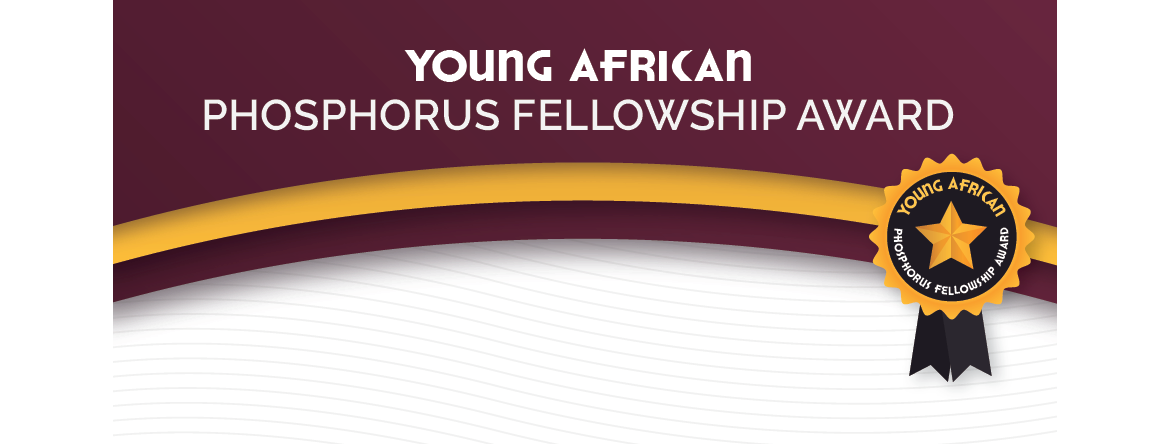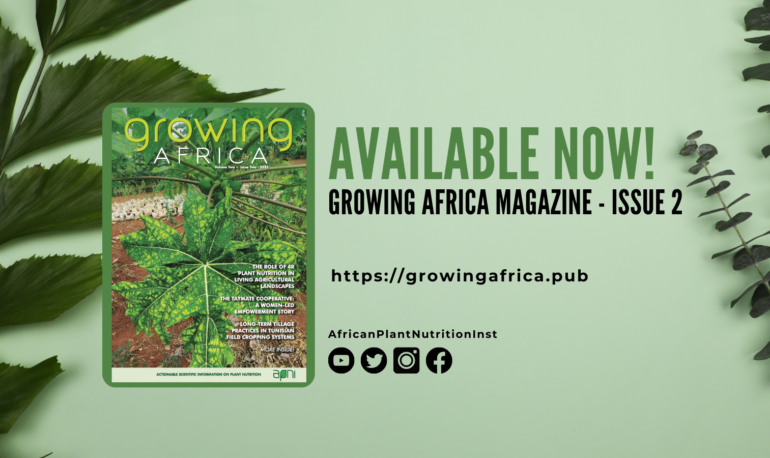
Young African Phosphorus Fellowship
Project Lead

African Plant Nutrition Institute
Implementing Partners

Mohammed VI Polytechnic University (UM6P)

OCP Group
Target Countries
African Continent
Other Targets
Improved phosphorus (P) management in African agro-ecosystems.
Short Description
The Young African Phosphorus Fellowship program was implemented in 2020 to encourage scientific programs relevant to understanding and improving phosphorus (P) management in African agro-ecosystems. Awards are conferred to early-career scientists working in an African NARES institution (National Agricultural Research and Extension System) or African university.
The application is only available on-line at www.apni.net/P-fellowship-apply.
2023 Selections
Dr. Primitiva Andrea Mboyerwa, College of Agriculture, Department of Soil and Geological Sciences, Sokoine University of Agriculture, Morogoro, Tanzania
Dr. Mboyerwa will be investigating the influences of alternate wet/dry (AWD) irrigation regimes and phosphorus (P) fertilizer application on rice yield and P use efficiency. Her study will compare these responses in both upland and lowland rice production systems with study sites in Morogoro (eastern Tanzania) and the higher yield potential region of Mbeya (southern Tanzania).
Phosphorus deficiency constitutes a major growth and yield-limiting factor in irrigated and rainfed rice systems in Tanzania. Most soils in Tanzania are highly weathered with high P sorption capacity and low P availability. Often farmers do not apply mineral P fertilizers which further contributes to a continuous decline in soil P fertility. This research will guide our knowledge for Tanzania rice production through its focus on yield improvement and the development of improved agronomic practices that can increase P availability, improve P fertilizer use efficiency, and encourage the judicious application of P inputs. Results are expected to support the development of best management practices for rice irrigation, fertilizer application and plant breeding technologies.
Dr. Mohamed Chtouki, College of Agriculture and Environmental Sciences, Mohammed VI Polytechnic University (UM6P), Benguérir, Morocco
The objective of Dr. Mohamed Chtouki’s research is to improve water and nutrient use efficiency from phosphorus (P)-based fertilizers applied to Moroccan cereal-legumes crop rotations. Based within the College of Agriculture and Environmental Sciences, Mohammed VI Polytechnic University (UM6P) in Benguérir, Morocco, Dr. Chtouki is interested in the novel application of the emerging technologies of spatial analysis using crop imaging and field mapping, geospatial modeling, and field-scale soil moisture assessment.
Under the arid and semi-arid conditions of Morocco, the impact of climate change on water resource availability and soil quality is more and more emphasized under Moroccan pedoclimatic conditions, mostly characterized by drought and extreme weather events, which negatively impact crop yield and quality. In this context, the development of innovative techniques to improve water and nutrient use efficiency has become a primary research question amongst soil and plant scientists, and agricultural stakeholders.
This innovative precision agriculture study will help our understanding of the dynamics of water and nutrients in the soil-plant continuum after P fertilizer application, guide P fertilizer use, assess soil spatial variability, and aid in the delineation of crop management zones for Moroccan cereal crop production systems.
2022 Selections
Dr. Uchechukwu Paschal Chukwudi—Lecturer, Department of Crop Science, University of Nigeria
The broad objective of this study is to assess rice farmers’ knowledge, perception, and use of phosphorus fertilization in the derived Guinea Savannah agro-ecological zone of Nigeria. Specifically, the study will 1) Identify and characterize the socioeconomic features of rice farmers, 2) assess the perceived constraints to phosphorus application in rice farming, 3) evaluate the farmers’ knowledge of phosphorus application in rice farming, and 4) enlighten farmers on the identified knowledge gap on phosphorus application in rice farming.
Closing the P and other nutrient cycles is a critical issue that must be addressed both locally and worldwide in order to improve P usage efficiency, fulfill stricter water quality and nutrient criteria, and provide affordable food in sustainable agricultural systems. As studies point to the need for increased fertilizer use in Nigeria for bumper yield, there is a need to raise awareness among Nigeria’s small-holder rice farmers, who account for 80% of the country’s rice production, about the benefits of using P fertilizer judiciously to produce a high yield without endangering the environment.
Mr. Tonny Phirilani Tauro — Lecturer (Soil microbiology), Marondera University of Agricultural Sciences and Technology, Marondera, Zimbabwe
The main objective of the study is to assess the impact of increasing P rates on soil available P, soil microbial dynamics, cereal yields and use efficiencies. The specific objectives are to: 1) determine the influence of increasing P rates on soil available P, soil microbial dynamics and P use efficiency, 2) evaluate the influence of soil microorganisms and pH dependent reactions on soil available P dynamics following P application under different fertilizer management systems (sole fertilizer vs co-application of organic and inorganic fertilizer), and 3) evaluate the economics of increasing P rates in maize cropping systems.
The study will focus on ways to unlock immobilized P in microbial biomass which is competing with crop. Increasing the application of inorganic P fertilizer is likely to offset microbial immobilization when other nutrients are adequately supplied, in particular nitrogen. The synergic relationship between phosphorus and nitrogen indicates that an offsetting response is likely when N, K, S and carbon are non-limiting. Microbial immobilization and release will proceed while the highly reactive phosphate anions react with Al, Fe, and clay materials. As such there is need to understand the actual pathway ultimately making P more available.
2021 Selections
Dr. Benjamin Karikari — Department of Crop Science, Faculty of Agriculture, Food and Consumer Sciences, University for Development Studies, Tamale, Ghana
Dr. Karikari’s project is investigating the potential for genetic improvement of P use efficiency in soybean.
“The identification of soybean germplasm with high adaptation to low-P-input environments may enhance soybean productivity and reduce the reliance on costly synthetic P fertilizers,” explains Dr. Karikari.
The study has the goal of improving our understanding of the genetic basis of P use efficiency (PUE) in Ghana, and will use the results to design a breeding program for improving PUE, or breed for soybean with optimum yield under limited soil P conditions.
Dr. Matheus Sampaio C. Barreto — AgroBiosciences Program, Mohammed VI Polytechnic University (UM6P), Benguérir, Morocco
Dr. Barreto’s project is a molecular-scale investigation of organic P sorption-desorption on soil mineral phase and its hydrolysis by phosphatase.
“The investigation of environmental constraints on adsorption-sorption of organic-P and the phosphates, as well as on the phosphatase’s enzymatic activities parameters after adsorption on minerals is a scientific challenge,” explains Barreto.
Overall, this project aims to use an advanced spectroscopic technique under in-situ and real time regime to unravel the adsorption-desorption of organic-P and phosphatase molecules on iron (Fe)-oxide mineral in single and binary systems. The outcomes for this work in molecular-scale organic-P environmental chemistry are required to improve the modeling and prediction of carbon and P cycles under natural environments.
Mr. Daniel Mjinja — School of Mines and Geosciences, University of Dar es Salaam, Dar es Salaam, Tanzania
Mr. Minja’s research is on the production of bone meal from animal bones as an alternative source of P in agriculture.
“Production of the bone meal will enhance environmental conservation policies since the animal bones which are regarded as wastes, will now be utilized to produce useful products, explains Mjinja.
The main objective is to produce and commercialize the bone meal as a low-cost P source.
Dr. Anthony Oyeogbe — Faculty of Agriculture, University of Ibadan, Ibadan, Nigeria
Dr. Oyeogbe is examining the influence of P on microbial nitrogen (N) transformation and nitrous oxide (N2O) emission.
“A deeper insight into sustainable P management, microbial soil N transformation, and N2O emissions has important implications for agronomic productivity and the prediction of global N2O emissions,” explains Oyeogbe.
The project aims to unravel the role of P in regulating soil N transformations and N2O emission through changes in the microbial community composition.
Mr. Guta Amante Sanbe — Ethiopian Institute of Agricultural Research, Teppi Agricultural Research Center, Jimma, Ethiopia
Mr. Sanbe’s is examining the potential of modified biochar to remove phosphate from liquid manure and re-use as alternative P fertilizer.
“The result of this study will improve our understanding of P management in agricultural soils especially for high P-fixing East African soils,” explains Sanbe.
The recommendation from the finding will show the way forward on improved understanding of P recycling by integration of biochar technology with nutrient rich livestock wastes, which will enhance P management towards smallholder African farmers.
2020 Selections
Dr. Austin PHIRI — Ministry of Agriculture Irrigation & Water Development, Department of Agricultural Research Services, Bvumbwe Agricultural Research Station, Limbe, MALAWI
Dr. Phiri is working to improve nutrient use efficiency and sorghum productivity through the pigeon pea-cowpea intercrop sorghum rotation cropping system among smallholder farmers in Malawi.
His research profiled the socio-economic, biophysical and gender status in the project areas in relation to soil fertility management and sorghum production. He assessed the performance of the pigeon pea-cowpea intercrop sorghum rotation cropping system under smallholder farmers’ conditions. He also determined P and nitrogen (N) use efficiency and yield of sorghum in rotation with the legumes as influenced by the incorporation of pigeon pea and cowpea biomass into the soil. Dr. Phiri’s work promoted the improved use of appropriate P and N fertilizer for sorghum production among Malawian farmers.
Related Outputs
Dr. Patrick MUSINGUZI — Department of Agricultural Production, School of Agricultural Sciences, College of Agricultural and Environmental Sciences, Makerere University, Kampala, UGANDA
Dr. Musinguzi’s research evaluated ‘legacy’ P in fertilized maize fields with the goal of improved fertilizer management in Uganda.
This work is revealing the potential of utilizing legacy P for sustaining soil productivity in highly P-fixing soils in the region. In each district, 18 farms that have been extensively using fertilizers will be selected and examined for the state of residual P in both fertilized and unfertilized maize fields. Recommendations for P-based fertilizer use will be developed based on legacy P data in order to increased the capacity for nutrient management in these tropical soils.
Related stories
Verifying suitable P fertilizer rates for improved crop production in the northern zone of Tanzania.
Mr. Seuri MOLLEL — Tanzania Agricultural Research Institute (TARI), Arusha, TANZANIA
Mr. Mollel verified suitable P fertilizer rates for improved crop production in the northern zone of Tanzania.
The research is intended to increase crop production by developing site-specific P fertilizer in three targeted districts of northern Tanzania. This work also involved participation by farmers throughout the process to ensure the high adoption of technology through the establishment of farmer-managed trials in these targeted districts.
Dr. Esther MUINDI — Department of Crop Sciences, School of Agricultural Sciences and Agribusiness, Pwani University, Kilifi, KENYA
Dr. Muindi studied improved P management within the Kenya highlands by consolidating and resynthesizing available laboratory data and then sharing with key agencies.
This project aggregated the already completed and analyzed data that has been shelved for 18 counties within the Kenya highlands. The project compiled and unified the P fertilizer recommendations so that they can then be disseminated back to farm organizations, county agricultural officers, local soil researchers, fertilizer manufacturers and policy makers. This synthesis of soil P management research will lead to improved fertilizer recommendations, enhanced fertilizer P efficiency, and greater agricultural production in the Kenyan highlands.




